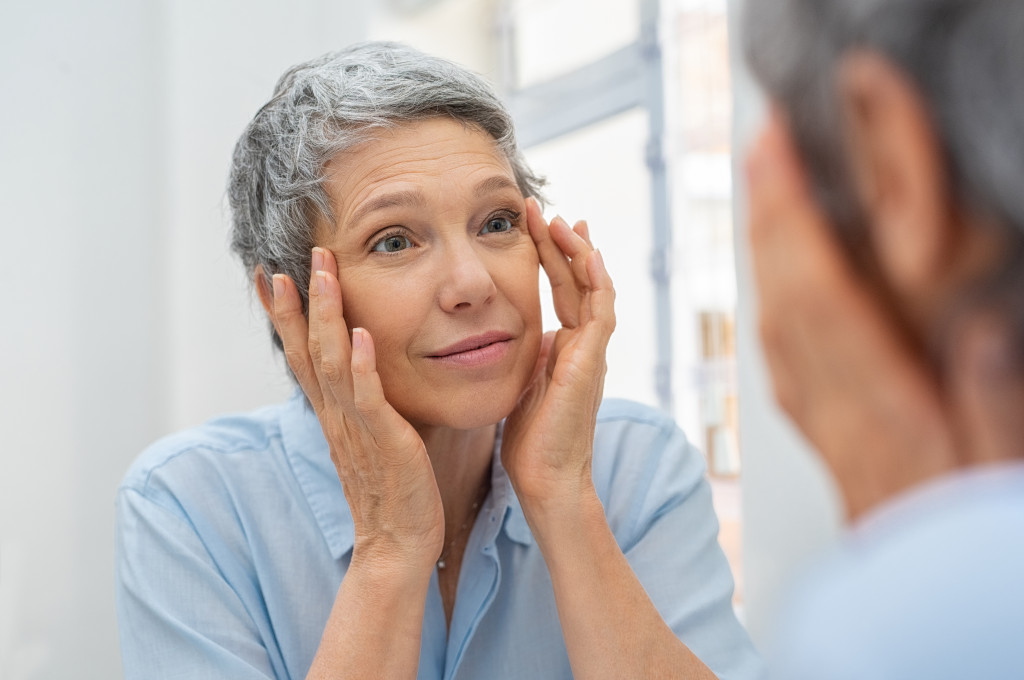- Aging decreases skin elasticity and firmness due to collagen and elastin loss, causing wrinkles and fine lines.
- Prolonged sun exposure leads to age spots, and aging weakens hair follicles, thinning eyebrows and eyelashes.
- Sagging skin results from reduced skin elasticity and fat loss, while decreased moisture and oil production cause dry skin.
- Prevention strategies include sunscreen use, a nutritious diet, hydration, ample sleep, and a consistent skincare routine.
- Understanding and accepting age-related skin changes and proper skincare habits help maintain healthy, youthful-looking skin.
As people grow older, a lot of changes occur in their bodies. And their faces are not an exception. Over time, the firmness and elasticity of their skin reduce due to the loss of collagen and elastin, resulting in various wrinkles and fine lines all over their faces. Additionally, people’s facial skin is exposed to environmental factors such as pollution, sun damage, and stress, which could contribute to changes as people age. Here’s what you need to know about skin and age, how your face changes as you grow older, and ways to maintain your skin’s health and appearance.
What Happens to Your Skin As You Age?
Aging is a natural process, and as much as people may want to stop it or slow it down, they can’t. Some of the common changes that occur in the skin as people age include:
1. Wrinkles and Fine Lines
One of the most visible signs of aging is wrinkles and fine lines. As you age, your skin loses its elasticity because of the loss of collagen and elastin. When you frequently make facial expressions, such as frowning, squinting, and smiling, the wrinkles and fine lines eventually appear due to the continuous strain. The best way to prevent wrinkles is by avoiding excessive sun exposure, having a healthy diet, and using moisturizers with SPF.

2. Age Spots
Age spots are brown or dark spots that appear on the skin’s surface due to prolonged exposure to the sun. They’re common in areas frequently exposed to the sun, such as the face, arms, and hands. The best way to prevent age spots is by using broad-spectrum sunscreen regularly and avoiding sun exposure for long durations.
3. Thinning Eyebrows and Eyelashes
Aging can also cause the eyelashes and eyebrows to become thin. This occurs because the hair follicles weaken and produce smaller, thinner hair strands. Although this change is common, it can be managed. You can try incorporating castor oil, olive oil, or aloe vera into your beauty routine to help strengthen and nourish your eyebrows and eyelashes.
4. Sagging Skin
Your skin’s elasticity reduces as you age, eventually leading to signs of sagging. The skin sags as we lose the fat holding everything in place. Fortunately, you can visit an experienced facial balancing doctor to help tighten and restore your skin’s elasticity. They can diagnose the cause of your sagging skin and recommend treatments such as injectables, lasers, or facelifts.
5. Dry Skin
Dry skin is another common factor that contributes to aging. Aging can force the skin to lose moisture, and oil production decreases, which leads to dryness. Dry skin can worsen the appearance of wrinkles and fine lines. To manage dry skin, it is recommended to moisturize your face more often and use gentle skin care products.
Prevention and Treatment
Aging is inevitable, but there are ways to maintain your skin’s health and appearance. Here are some tips to prevent or manage signs of aging:

Sunscreen
Sunscreen is the most crucial step to prevent your skin from aging. It’s essential to wear sunscreen with an SPF of 30 or higher daily, regardless of the weather.
A Healthy Diet
Eating a nutritious diet can help reduce signs of aging. Foods rich in antioxidants, such as fruits and vegetables, can help protect against free radicals that cause cellular damage. Additionally, foods containing healthy fats like omega-3 fatty acids found in fish and nuts promote healthy and radiant skin.
Stay Hydrated
Keeping your body hydrated also plays a significant role in maintaining youthful-looking skin. Drinking enough water helps flush out toxins from your body, keeping your skin well-hydrated and plump.
Get Enough Sleep
Sleeping allows your body to repair and rejuvenate itself, including the skin. Lack of sleep can lead to signs of aging, such as dark circles under the eyes and dull skin. It’s recommended to get at least 7-9 hours of quality sleep each night.
Adopt a Skincare Routine
It’s never too early or late to start caring for your skin. Adopting a daily skincare routine that includes cleansing, moisturizing, and exfoliating can help keep your skin healthy and youthful-looking.
Everyone ages differently, but changes in the skin are inevitable as we grow older. Understanding how our faces change with age and adopting proper skincare habits can help maintain your skin’s health and appearance for years. Remember always to protect your skin from the sun, eat a healthy diet, and stay hydrated for radiant and youthful-looking skin. So, it’s essential to take care of our skin every day and embrace the natural process of aging.


